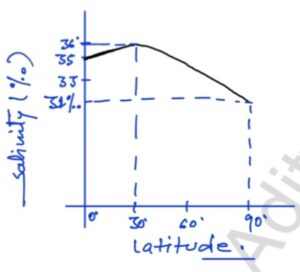What are the artificial and natural elements influencing the ocean’s salinity budget?
The observed shrinkage of the Greenland Ice Sheet (GrIS) and its implications can be attributed to several interconnected factors: 1. Climate Change and Warming Temperatures: - Increased Temperature: Greenland has been experiencing significant warming due to climate change. Warmer temperatures leadRead more
The observed shrinkage of the Greenland Ice Sheet (GrIS) and its implications can be attributed to several interconnected factors:
1. Climate Change and Warming Temperatures:
– Increased Temperature: Greenland has been experiencing significant warming due to climate change. Warmer temperatures lead to increased melting of ice on the surface of the ice sheet.
– Albedo Effect: As snow and ice melt, they expose darker surfaces (like bare ground or melt ponds) which absorb more solar radiation, further accelerating melting.
2. Oceanic and Atmospheric Circulation Changes:
– Changing Ocean Currents: Alterations in ocean currents can bring warmer water closer to Greenland, leading to increased melting at the ice sheet’s edges where glaciers meet the ocean.
– Atmospheric Circulation: Changes in atmospheric circulation patterns can influence precipitation patterns and temperature distributions, affecting the mass balance of the ice sheet.
3. Feedback Mechanisms:
– Positive Feedback Loops: Melting of ice reduces the reflective surface area (albedo effect), leading to more absorption of solar radiation and further warming, which accelerates melting.
– Ice Dynamics: Increased melting can also affect the dynamics of ice flow, potentially speeding up the movement of glaciers into the ocean (ice discharge), contributing to sea-level rise.
4. Direct and Indirect Consequences:
– Sea-Level Rise: The biggest concern is the contribution of melted ice from Greenland to global sea-level rise. Even small changes in the Greenland Ice Sheet can have significant impacts on coastal communities worldwide.
– Ecological Impacts: Changes in the ice sheet affect local ecosystems and wildlife that depend on stable ice conditions.
– Human Impacts: Coastal communities, particularly in low-lying areas, face increased risk of flooding and displacement due to rising sea levels.
5. Scientific and Societal Responses:
– Scientific Research: Ongoing monitoring and research efforts are crucial for understanding the dynamics of the ice sheet and predicting future changes.
– Policy and Mitigation: International agreements and policies aimed at reducing greenhouse gas emissions and mitigating climate change are essential to address the underlying causes of ice sheet shrinkage.
In conclusion, the shrinkage of the Greenland Ice Sheet is primarily driven by climate change-induced warming, leading to increased melting and dynamic changes in ice flow. The consequences extend beyond Greenland, impacting global sea levels and ecosystems, necessitating urgent action to mitigate climate change and adapt to its effects.
See less

 However, the Intergovernmental Panel on Climate Change (IPCC) in its recent report highlighted that AMOC is losing its stability and is very likely to decline over the 21st century due to the following reasons:
However, the Intergovernmental Panel on Climate Change (IPCC) in its recent report highlighted that AMOC is losing its stability and is very likely to decline over the 21st century due to the following reasons:

The salinity budget of oceans refers to the quantification and analysis of the processes and mechanisms that influence the distribution, variation, and maintenance of dissolved salt content within seawater across global marine systems. It is affected by natural as well as anthropogenic factors as exRead more
The salinity budget of oceans refers to the quantification and analysis of the processes and mechanisms that influence the distribution, variation, and maintenance of dissolved salt content within seawater across global marine systems. It is affected by natural as well as anthropogenic factors as explained below:
Factors Affecting the Salinity Budget of Oceans: Natural Factors:
To conclude, ocean salinity encapsulates the fragile equilibrium between nature and human factors. However, escalating anthropogenic disruptions are jeopardizing this equilibrium, emphasizing the imperative of environmental action. By adopting sustainable measures, combating pollution, and addressing climate change, we can collaboratively restore oceanic salinity balance and foster a harmonious coexistence between the natural world and human society.
See less